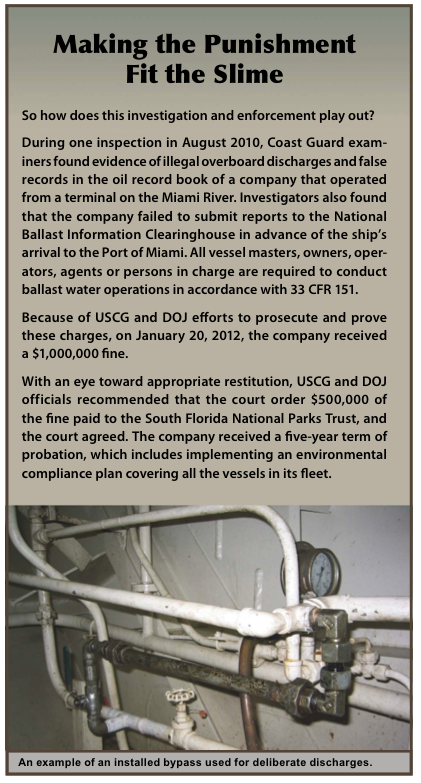US COAST GUARD DEPARTMENT OF INVESTIGATIONS AND ANALYSIS
Slime and Punishment
by LT ERIC RIVERA- Investigations Division
One of the unique aspects of the U.S. Coast Guard is that it functions as a military force as well as a law enforcement agency. With that in mind, the USCG has found itself in the forefront of the fight against maritime pollution.
The Coast Guard relies heavily on the assistance of its port state control program to identify environmental deficiencies and coordinate actions against those who commit maritime pollution acts. Port state control examiners perform a number of duties including vessel exams, which begin prior to a vessel’s entry into port. These exams cover three aspects of the ship’s operations: safety, security, and pollution prevention.
The Partnership for Clean Water
The USCG is the primary federal agency responsible for investigating marine environmental crimes; however, Congress has not granted the Coast Guard power to prosecute these cases. Therefore, the Coast Guard elicits help from other federal agencies such as the Department of Justice (DOJ) to pursue such cases aggressively, and hold all guilty parties responsible for their crimes.
This procedure starts when Coast Guard officials determine that a violation of an environmental regulation may be criminal. The Coast Guard issues a recommendation to the DOJ to file charges against the suspect. After investigating the case further, U.S. attorneys decide whether to proceed with the case.
To determine if an action is criminal, prosecutors examine various elements, including:
- the extent of the damages,
- whether intent is shown,
- if the violator is cooperative,
- whether there have been violations like this in the past.
If DOJ officials determine there is enough evidence of a crime and decide to file charges, the defendant has the same constitutional rights and protections that are afforded to private citizens in any criminal case. Although criminal proceedings may deter future misconduct by the alleged perpetrators, they also likely deter those who may be tempted to perform similar offenses.
The Burden of Proof
Environmental crimes happen all over the U.S. and its territories and may involve international, federal, or state law violations, which means DOJ representatives can bring charges at each of these levels. While international cases typically focus on violations of various treaties, those that are filed at the local level are usually based on violations of environmental regulations.
These environmental offenses usually involve introducing hazardous material or other pollutants into the water. To bring criminal charges, however, the government must be able to show that the discharge was intentional.
The Rules
The Clean Water Act, as amended by the Oil Pollution Act, prohibits the discharge of oil or hazardous substances in such quantities as may be harmful, into or upon U.S. navigable waters, adjoining shorelines, or into or upon the waters of the contiguous zone or which may affect natural resources in the U.S. exclusive economic zone. Regulation 33 CFR 151.10 prohibits the discharge of oil within 12 nautical miles of shore, unless passed through a 15 parts-per-million oily water separator. Under 33 CFR 151.25, vessels are required to maintain an oil record book, which must record the disposal of oily residues and the discharge overboard, or disposal of bilge water produced in the engine space.
The International Convention for the Prevention of Pollution from Ships (MARPOL) is the main international convention covering prevention of pollution of the marine environment by ships from operational or accidental causes. MARPOL contains six annexes, each of which is concerned with preventing pollution from various shipboard operations. For example, the fuel, oil, onboard spills, and waste water from engines and other machinery that accumulates in the bilges is meant to be discharged over board through the oily water separator. However, if the content of the bilge waste is more than 15 parts per million, it must be sent to a shore-side regulated facility capable of receiving this waste.
Unfortunately, some operators elect to cut corners and discharge illegally overboard, bypassing oily discharge preventative equipment.
Read full report (or download PDF): The Marine Casualty Investigation Process
About US Coast Guard Office of Investigations & Casualty Analysis
www.uscg.mil/hq/cg5/cg545/
“We lead Coast Guard’s investigation program to promote safety, protect the environment, and to prevent future accidents. The Office of Investigations and Analysis is directed by CAPT David S. Fish. Mr. Timothy J. Farley serves as the Deputy Office Chief and also as the Division Chief of Investigations Division (CG-INV-1). The Analysis Division (CG-INV-2) is headed by CDR Andrew P. Wood. And the Data Administration and FOIA Division (CG-INV-3) is headed by the Division Chief Ms. Dawn Patterson.”
Tags: Marine Casualty Investigation Process, Slime and Punishment, U.S. Coast Guard, water pollution







 RSS Feed
RSS Feed